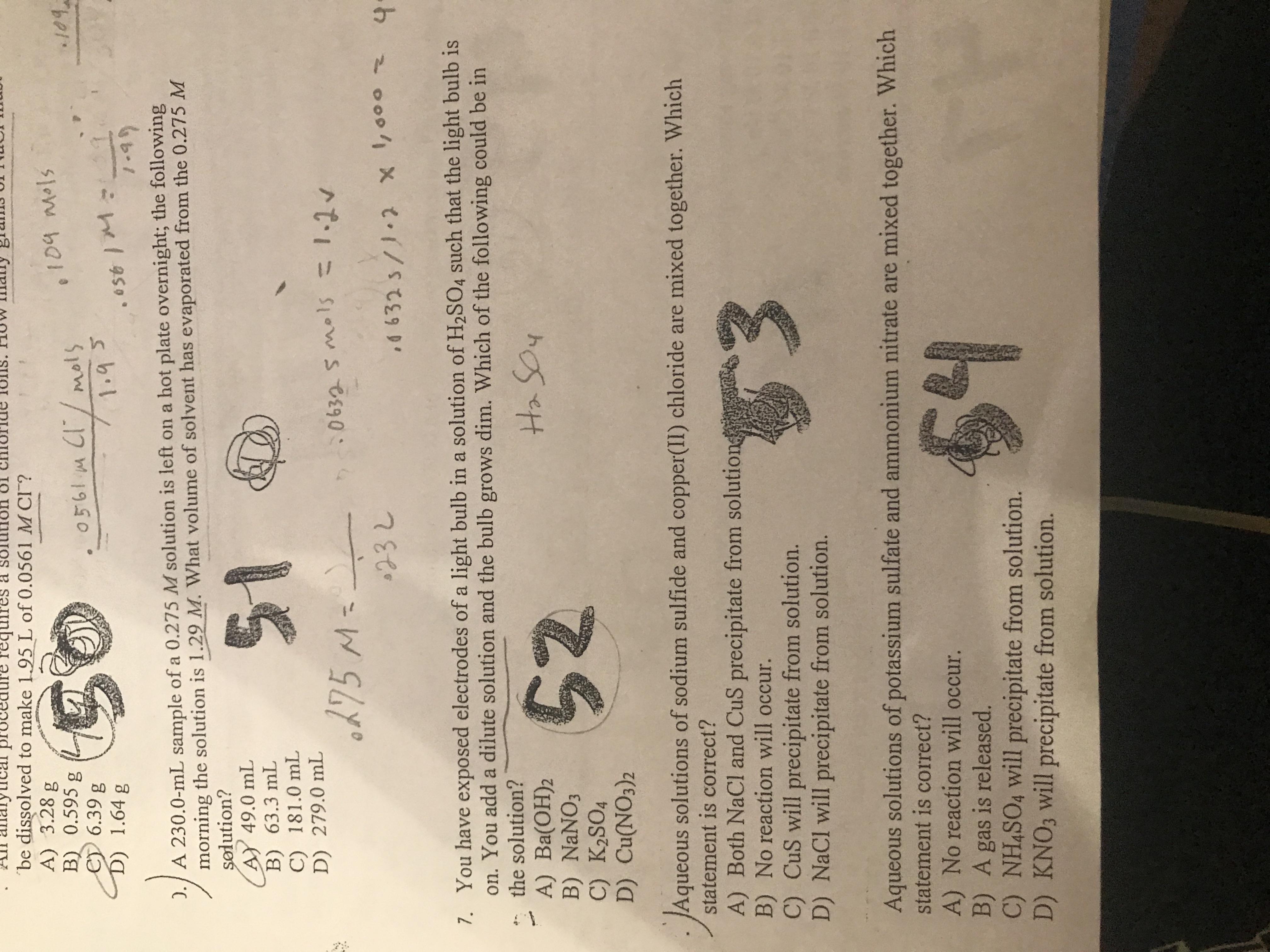
Chemistry
10th Edition
ISBN: 9781305957404
Author: Steven S. Zumdahl, Susan A. Zumdahl, Donald J. DeCoste
Publisher: Cengage Learning
expand_more
expand_more
format_list_bulleted
Concept explainers
Question
You have expose electrodes the lightbulb in a solution of H2 S04 such that the lightbulb is on you add a dilute solution and the ball goes dim which of the following could be in the solution

Transcribed Image Text:### Chemistry Problem Set
**Question 5:**
An analytical procedure requires a solution of chloride ions. How many grams of KCl must be dissolved to make 1.95 L of 0.0561 M Cl⁻?
- A) 3.28 g
- B) 0.595 g
- C) 6.39 g
- D) 1.64 g
*(Solution indicated as choice C: 6.39 g)*
**Question 6:**
A 230.0 mL sample of a 0.275 M solution is left on a hot plate overnight; the following morning the solution is 1.29 M. What volume of solvent has evaporated from the 0.275 M solution?
- A) 49.0 mL
- B) 63.3 mL
- C) 181.0 mL
- D) 279.0 mL
*(Solution indicated as choice A: 49.0 mL)*
**Question 7:**
You have exposed electrodes of a light bulb in a solution of H₂SO₄ such that the light bulb is on. You add a dilute solution and the bulb grows dim. Which of the following could be in the solution?
- A) Ba(OH)₂
- B) NaNO₃
- C) K₂SO₄
- D) Cu(NO₃)₂
*(Solution indicated as choice A: Ba(OH)₂)*
**Question 8:**
Aqueous solutions of sodium sulfide and copper(II) chloride are mixed together. Which statement is correct?
- A) Both NaCl and CuS precipitate from solution.
- B) No reaction will occur.
- C) CuS will precipitate from solution.
- D) NaCl will precipitate from solution.
*(Solution indicated as choice C: CuS will precipitate from solution)*
**Question 9:**
Aqueous solutions of potassium sulfate and ammonium nitrate are mixed together. Which statement is correct?
- A) No reaction will occur.
- B) A gas is released.
- C) NH₄SO₄ will precipitate from solution.
- D) KNO₃ will precipitate from solution.
*(Solution indicated as choice A: No reaction will
Expert Solution
This question has been solved!
Explore an expertly crafted, step-by-step solution for a thorough understanding of key concepts.
This is a popular solution
Trending nowThis is a popular solution!
Step by stepSolved in 2 steps with 2 images

Knowledge Booster
Learn more about
Need a deep-dive on the concept behind this application? Look no further. Learn more about this topic, chemistry and related others by exploring similar questions and additional content below.Similar questions
- What is the percentage of HCl in the solution if the molarity is 0.268398000? Assume the density of the solution is 1.00 g/mL.arrow_forwardEach row of the table below describes an aqueous solution at about 25 °C. Complete the table. That is, fill in any missing entries in the second column. Be sure each entry you write includes the correct number of significant digits. [H₂O¹] solution A B с mol/L mol/L mol/L pH 11.49 0.090 7.92 0 10 X Sarrow_forwardQ4: what is the correct answer choicearrow_forward
- Which of the following substances are strong electrolytes? O Multiple answers: Multiple answers are accepted for this question Select.one or more answers and submit. For keyboard navigation.. SHOW MORE V CH3COOH b. Ca(NO3)2 HBr KOH e NH3 f NaClarrow_forwardWater is the solvent of choice to separate a mixture of adipic acid and salicylic acid because it dissolves both substances easily. Group of answer choices True Falsearrow_forwardEach row of the table below describes an aqueous solution at about 25°C . Complete the table. That is, fill in any missing entries in the second and third columns. Be sure each entry you write includes the correct number of significant digits. solution H3O+ pH A 0.0078mol/L B mol/L 7.32 C ×4.910−12mol/Larrow_forward
arrow_back_ios
arrow_forward_ios
Recommended textbooks for you
 ChemistryChemistryISBN:9781305957404Author:Steven S. Zumdahl, Susan A. Zumdahl, Donald J. DeCostePublisher:Cengage Learning
ChemistryChemistryISBN:9781305957404Author:Steven S. Zumdahl, Susan A. Zumdahl, Donald J. DeCostePublisher:Cengage Learning ChemistryChemistryISBN:9781259911156Author:Raymond Chang Dr., Jason Overby ProfessorPublisher:McGraw-Hill Education
ChemistryChemistryISBN:9781259911156Author:Raymond Chang Dr., Jason Overby ProfessorPublisher:McGraw-Hill Education Principles of Instrumental AnalysisChemistryISBN:9781305577213Author:Douglas A. Skoog, F. James Holler, Stanley R. CrouchPublisher:Cengage Learning
Principles of Instrumental AnalysisChemistryISBN:9781305577213Author:Douglas A. Skoog, F. James Holler, Stanley R. CrouchPublisher:Cengage Learning Organic ChemistryChemistryISBN:9780078021558Author:Janice Gorzynski Smith Dr.Publisher:McGraw-Hill Education
Organic ChemistryChemistryISBN:9780078021558Author:Janice Gorzynski Smith Dr.Publisher:McGraw-Hill Education Chemistry: Principles and ReactionsChemistryISBN:9781305079373Author:William L. Masterton, Cecile N. HurleyPublisher:Cengage Learning
Chemistry: Principles and ReactionsChemistryISBN:9781305079373Author:William L. Masterton, Cecile N. HurleyPublisher:Cengage Learning Elementary Principles of Chemical Processes, Bind...ChemistryISBN:9781118431221Author:Richard M. Felder, Ronald W. Rousseau, Lisa G. BullardPublisher:WILEY
Elementary Principles of Chemical Processes, Bind...ChemistryISBN:9781118431221Author:Richard M. Felder, Ronald W. Rousseau, Lisa G. BullardPublisher:WILEY

Chemistry
Chemistry
ISBN:9781305957404
Author:Steven S. Zumdahl, Susan A. Zumdahl, Donald J. DeCoste
Publisher:Cengage Learning

Chemistry
Chemistry
ISBN:9781259911156
Author:Raymond Chang Dr., Jason Overby Professor
Publisher:McGraw-Hill Education

Principles of Instrumental Analysis
Chemistry
ISBN:9781305577213
Author:Douglas A. Skoog, F. James Holler, Stanley R. Crouch
Publisher:Cengage Learning

Organic Chemistry
Chemistry
ISBN:9780078021558
Author:Janice Gorzynski Smith Dr.
Publisher:McGraw-Hill Education

Chemistry: Principles and Reactions
Chemistry
ISBN:9781305079373
Author:William L. Masterton, Cecile N. Hurley
Publisher:Cengage Learning

Elementary Principles of Chemical Processes, Bind...
Chemistry
ISBN:9781118431221
Author:Richard M. Felder, Ronald W. Rousseau, Lisa G. Bullard
Publisher:WILEY